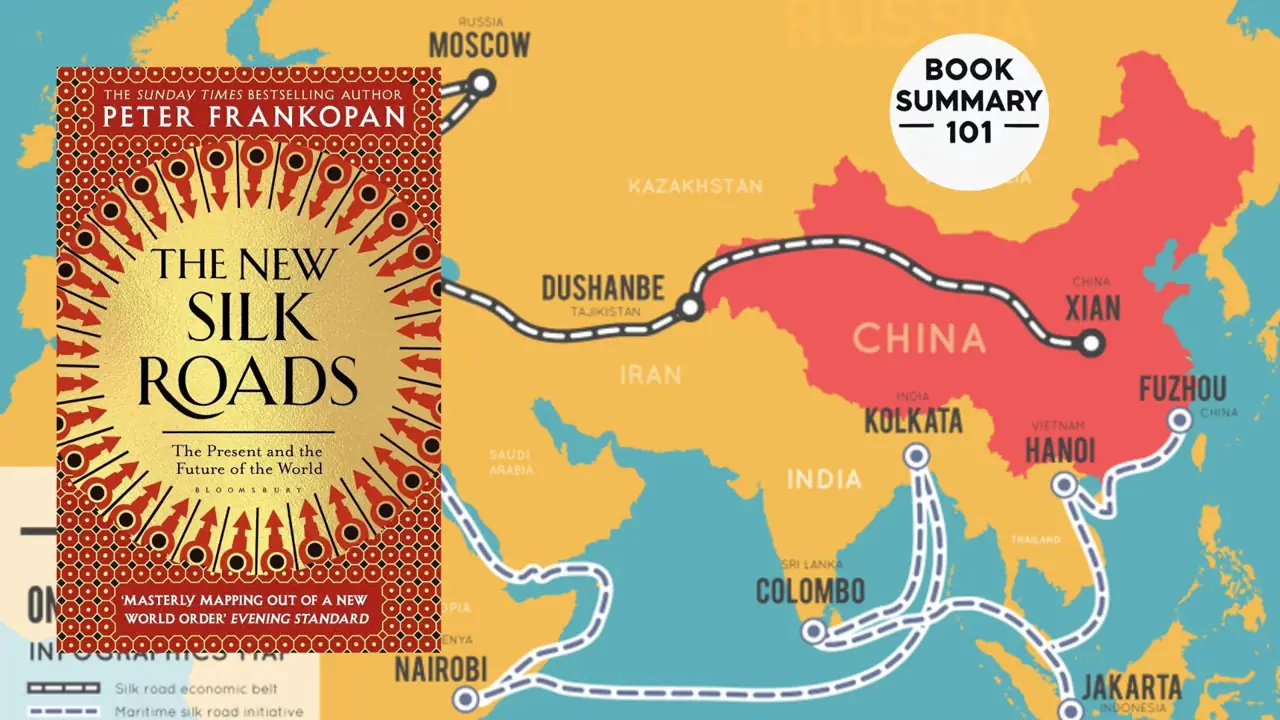Imagine if the world’s power balance was a giant map—and it’s tilting eastward. That’s what Peter Frankopan dives into in The New Silk Roads: The New Asia and the Remaking of the World Order. This isn’t just another economics or politics book. It’s a sweeping look at the forces, nations, and players behind one of the most significant transformations in modern history. Frankopan guides us through the shifts in global power, economy, and culture with Asia, particularly China and the surrounding regions, as the center of it all.
Why Read This Book?
Here’s what makes The New Silk Roads stand out. While it explores big ideas—like geopolitics, trade routes, and international relations—Frankopan keeps it approachable, connecting the past to the present in a way that lets us feel the weight of these changes. He uses relatable examples and emphasizes how these shifts will affect us, not just as countries but as individuals navigating a world where the East is rising in influence.
Think about it: what happens to the global economy, environmental efforts, and even the content you see online when Asia becomes the main player? What role will the U.S. play? And what about Europe and the rest of the West? This book doesn’t just offer theories; it shows us the real and practical impacts of a changing world order.
Exploring the “New Silk Roads”
Peter Frankopan’s The New Silk Roads takes us on an insightful tour of how the global balance of power is shifting and how countries are shaping their roles in this new world order. Each of the following takeaways dives into key forces that are transforming our modern Silk Roads.
China and the Belt and Road Initiative (BRI): The Backbone of a New Global Network
The Belt and Road Initiative (BRI) is China’s multi-trillion-dollar infrastructure project that aims to resurrect the ancient Silk Road and modernize it for today’s world. This ambitious effort spans over 60 countries, connecting Asia, Europe, and Africa through an intricate network of railways, ports, pipelines, highways, and more. China’s approach is straightforward: by investing in critical infrastructure worldwide, it can build strong economic and political ties with other nations. However, there’s a deeper strategy at play. As these nations become increasingly dependent on Chinese investments, China strengthens its geopolitical influence, creating a sphere of influence that mirrors that of the old Silk Road, but on a larger, more global scale.
While the BRI promises economic growth for participating nations, there’s a catch: many of these countries, especially smaller and less economically stable ones, could fall into debt traps. For example, some nations have taken on huge loans from China to fund massive infrastructure projects, leaving them financially indebted and potentially vulnerable to political pressure from Beijing. This situation raises critical questions about national sovereignty and the implications of relying heavily on a single foreign power for development.
Example: Sri Lanka’s Hambantota Port was funded by Chinese loans and eventually fell into financial trouble, causing Sri Lanka to lease the port to China for 99 years. This example shows how strategic investments can lead to direct control, and it fuels concerns about how much influence China may accumulate over other nations.
Gwadar Port in Pakistan—A Game Changer with Strings Attached
The Gwadar Port in Pakistan’s Balochistan region has become a symbolic project under the BRI. Positioned near the mouth of the Persian Gulf, Gwadar serves as a gateway to the Middle East, making it an ideal location for trade and energy transportation. With substantial Chinese investment, this once-quiet coastal area has transformed into a bustling hub of economic activity. But it’s more than just an infrastructure project; Gwadar is a critical strategic asset for China’s energy security, allowing it to bypass potentially volatile choke points like the Strait of Malacca.
However, for Pakistan, this partnership with China brings both opportunities and challenges. On one hand, Gwadar has created jobs and sparked development in one of Pakistan’s least developed regions. On the other hand, Pakistan faces risks associated with its reliance on Chinese funding. Local populations, especially those in Balochistan, have voiced concerns about being left out of the benefits, sparking tension and even conflict. Gwadar highlights both the transformative potential and the complicated local dynamics of these new Silk Road projects.
Example: Gwadar’s rapid development has created both excitement and apprehension within Pakistan, illustrating how BRI projects often come with social, economic, and even political complexities that aren’t immediately obvious.
Russia and China: Strategic Partners or Future Competitors?
China and Russia are both strong players on the global stage, each with ambitions to shape the world in their favor. Currently, they share an understanding that challenging Western dominance can be mutually beneficial. However, as Frankopan points out, this relationship is marked by a cautious pragmatism rather than a close friendship. Russia’s vast resources and geographical positioning align well with China’s need for energy and access to Europe. By partnering with Russia on projects like the Power of Siberia gas pipeline, China secures essential resources, and Russia gains an eager customer and an alternative to Western markets.
Yet, the big question remains: can this cooperation hold? Russia and China have overlapping spheres of influence, especially in Central Asia, where both are vying for economic and political influence. Central Asia is rich in natural resources and holds a strategic position, making it a region of significant interest for both nations. While China invests heavily in Central Asia’s infrastructure, Russia relies on historical ties and cultural influence to maintain its presence. This creates potential friction points that may strain their current understanding and, down the line, could lead to competition rather than collaboration.
Example: Think of this like two giant neighbors sharing a fence—cooperative for now, but each with its eye on the other’s yard. Central Asia is that shared space, with Russia building on its Soviet legacy and China bringing in billions in investment, each hoping to win over the region’s loyalties.
Iran’s Resilience and Strategic Position on the New Silk Roads
Iran’s geographic location places it in a strategic position at the crossroads of Asia and Europe. Despite years of economic sanctions and political isolation from the West, Iran has managed to position itself as a vital partner for China’s Belt and Road Initiative. Iran’s access to the Persian Gulf and proximity to Central Asia make it a crucial link in China’s new Silk Roads vision, connecting Chinese markets to the Middle East and Europe.
Iran’s relationship with China goes beyond infrastructure. China has committed to investing $400 billion in Iran’s energy and infrastructure sectors over the next 25 years. In return, Iran offers oil at discounted rates to China, a win-win that allows both nations to bypass Western influence and continue economic growth. But this partnership is complex; Iran still faces international scrutiny and economic sanctions, creating a potential risk for China. Frankopan explains that by betting on Iran, China is challenging the established Western economic order, testing how far it can push boundaries while maintaining its role in the global economy.
Example: Iran is like a gateway between East and West. By partnering with China, it hopes to transform itself from a sidelined nation into a thriving economic bridge. This example captures how the Silk Roads are about more than just money—they’re about making bold political statements.
The Rise of Asian Technology Giants: China’s Digital Silk Road
Beyond physical infrastructure, China is creating a “Digital Silk Road,” which aims to position Chinese tech companies as leaders in global technology infrastructure. This strategy sees Chinese companies like Alibaba, Huawei, and Tencent expanding beyond domestic markets to influence tech ecosystems in regions like Southeast Asia, Africa, and even parts of Europe. China is exporting everything from 5G infrastructure to digital payment systems, building a network of digital dependencies as these nations adopt Chinese-made technology.
This expansion comes with significant benefits for China: it increases its global influence and offers an alternative to the U.S.-led tech ecosystem. However, the digital Silk Road also raises concerns over data privacy, surveillance, and dependency. As countries adopt Chinese technologies, they may face security risks and give up some control over their digital infrastructures. This digital influence isn’t just about the economy; it’s about shaping the information people see, how they communicate, and who holds the power to control it.
Example: Kenya recently adopted Huawei’s mobile payment systems, with many residents now using it to transfer money and conduct business. It’s a reminder of how quickly a tech giant can integrate into daily life, shaping even how people pay for groceries or commute. This digital Silk Road shows that influence isn’t just about trade routes—it’s about winning the hearts and wallets of people.
What Makes The New Silk Roads Unique?
The New Silk Roads is more than an exploration of geopolitics—it’s a look into the heart of an interconnected world where technology, resources, and trade routes are creating new winners and losers. Frankopan’s approach is both historical and contemporary, reminding us that the power dynamics of today are rooted in ancient paths.
He also touches on the human impact, like the shifts in job markets, migration, and daily life. These stories are told in a conversational way, showing how someone in Cairo, Shanghai, or Istanbul might experience the changing world order firsthand. Frankopan makes you feel like you’re part of this journey—like you’re walking along those roads, seeing the world transform from the ground up.
Join the Conversation!
Frankopan’s The New Silk Roads leaves readers with a sense of urgency and curiosity. How will countries respond to China’s expansion? Will Russia and China remain allies, or will they split? Can Europe maintain its influence, and where does this leave the U.S.?
As we enter an era that’s neither fully Western nor Eastern, Frankopan’s insights can help us understand where we fit into this new, interconnected world. So, if you’re curious about the forces that will shape the next decade—or even the next century—The New Silk Roads is a must-read.
Have thoughts on these shifts? Drop them below—let’s talk about how we see our future unfolding on these “new silk roads.”
5 powerful quotes from The New Silk Roads by Peter Frankopan
1. “We are living in a time of transition—of uncertainty, of shifting perspectives and of dramatically changing horizons.”
This quote sets the tone for the entire book. Frankopan reminds us that the global landscape isn’t static—it’s in flux, and we’re living right in the middle of that transformation.
2. “The Silk Roads are rising again. But this time, they do not just stretch from China to the Mediterranean. They are global.”
It’s not just about East meeting West anymore—it’s a worldwide web of trade, influence, and power that’s being rewoven in real time.
3. “Power and wealth are shifting—fast—and from West to East.”
A blunt but accurate summary of the book’s core argument. Whether we’re talking about economics, technology, or political clout, the East is becoming the new center of gravity.
4. “Those who do not look eastwards are not just ignoring the future—they are misunderstanding the present.”
A powerful call to pay attention. Frankopan isn’t just telling a story of what might happen—he’s urging us to recognize what’s happening right now.
5. “The world is being rewired, and the connections being made today will shape the decades to come.”
From roads and ports to digital infrastructure, this quote captures how deeply integrated the new Silk Roads are into the future of globalization.


